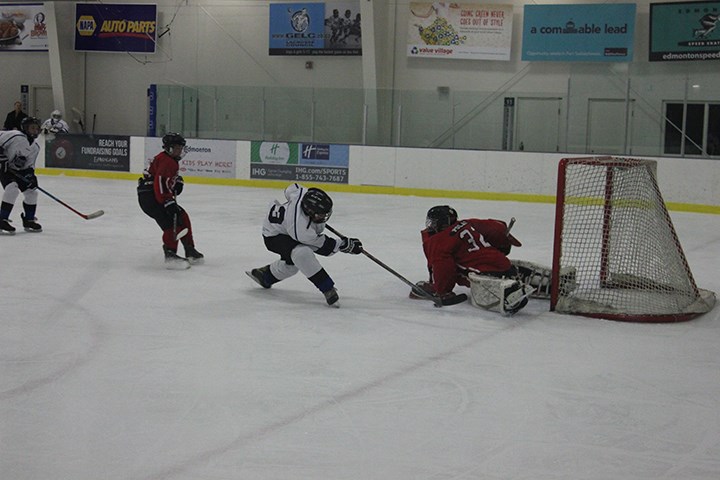 by Evan Matthews | [email protected]
by Evan Matthews | [email protected]
For the first time, Jasper Minor Hockey’s Bantam Bearcats are playing in a non-contact hockey league as part of a pilot project as parents look to make an impact of their own.
Bantam is Alberta Hockey’s age category for 13- and 14-year-olds, and is the age category in which body checking is introduced. Previously the Bearcats have always played in the Northern Alberta Interlock League, but the league doesn’t offer any non-contact variation of the sport.
Enter the Edmonton Federation Hockey League.
“Our first two games were last weekend,” says manager Krista Bartziokas. (See related story on page 11.)
“We didn’t really know where we were going to fit in, as it’s a really high level of hockey. We were really pleased with the calibre of the teams we played, but we definitely have our work cut out for us.”
Some of that work will include focusing on the players’ puck skills for a non-contact league versus emphasizing body position and finishing checks in a contact league, according to coaches.
But generally, coaches are saying the transition from contact to non-contact isn’t that huge.
“The bigger issue is child development between the ages of 12 and 18. When you get 100 lbs. kids playing against kids who are 230 lbs., there is going to be more potential for physical injury just strictly with the weight differentiation and body size,” says Steve Malcolm, director of Jasper Minor Hockey.
“Everybody grows differently. Once you get to the junior ranks, all the players are relatively close in size.”
Some “hockey” people believe by taking out contact, a crucial element of the sport has been removed. However, with concussions and CTE at the forefront of many sports discussions of late, parents are becoming more aware.
“A lot of us are parents. With contact sports there is always a risk of concussion,” says Malcolm. “Many parents no longer view that as acceptable risk.”
Because the league is based out of Edmonton, scheduling will depend on the willingness of other teams to travel to Jasper, as Malcolm says technically every single game could be an “away” game in Edmonton.
While the commute makes things slightly more difficult for Jasper parents, it was the best option because non-contact is offered. Malcolm says between the kids and the parents, Jasper Minor Hockey couldn’t afford to have so many players quit.
“It was a matter of survival. The unattractiveness of contact was an issue,” says Malcolm.
“A lot of kids aren’t keen on playing contact hockey, so they drop out by Bantams. We lose from about 40 to 50 on average, that’s quite a significant drop.”
Numbers get so low in Jasper’s older age categories often because parents are less keen on having the kids hit one another, according to Malcolm, plus kids have other activities like baseball, soccer, and mountain biking to focus on as alternatives.



